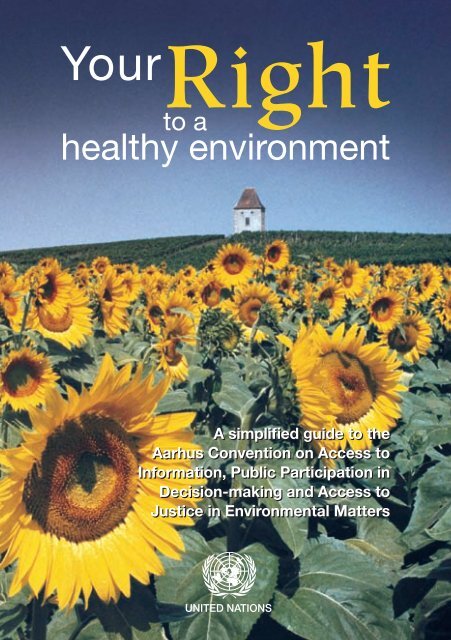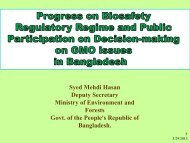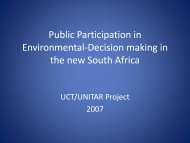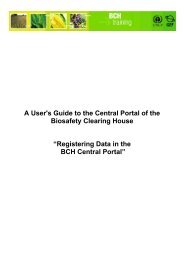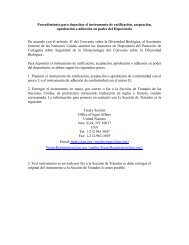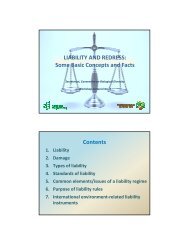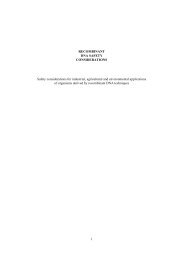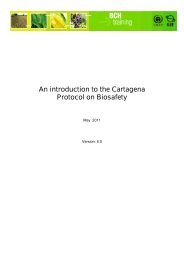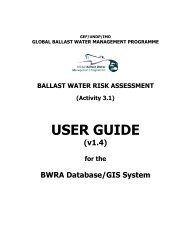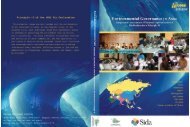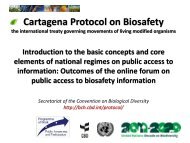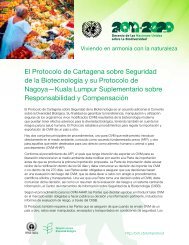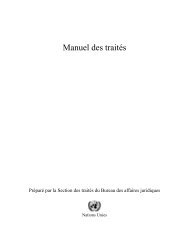Your Right to a Healthy Environment - UNECE
Your Right to a Healthy Environment - UNECE
Your Right to a Healthy Environment - UNECE
- No tags were found...
Create successful ePaper yourself
Turn your PDF publications into a flip-book with our unique Google optimized e-Paper software.
<strong>Your</strong><strong>Right</strong><strong>to</strong> ahealthy environmentA simplified guide <strong>to</strong> theAarhus Convention on Access <strong>to</strong>Information, Public Participation inDecision-making and Access <strong>to</strong>Justice in <strong>Environment</strong>al MattersUNITED NATIONS
NOTEThe designations employed and the presentation of the material in this publication donot imply the expression of any opinion whatsoever on the part of the Secretariat ofthe United Nations concerning the legal status of any country, terri<strong>to</strong>ry, city or area, orof its authorities, or concerning the delimitation of its frontiers and boundaries.__________Published by the United Nations Economic Commission for Europe and the UnitedNations <strong>Environment</strong> Programme in July 2006. Produced by <strong>UNECE</strong>’s Secretaria<strong>to</strong>f the Aarhus Convention and UNEP’s Division for <strong>Environment</strong>al Conventions. Thisbook is intended for public information purposes only and is not an official document.Permission is granted <strong>to</strong> reproduce or translate the contents giving appropriatecredit.For more information, please contact:Secretariat of the Aarhus ConventionUnited Nations Economic Commission for Europe<strong>Environment</strong>, Housing and Land Management DivisionPalais des Nations, 8-14 avenue de la Paix1211 Geneva 10Switzerland+41 22 917 1502public.participation@unece.orgOfficial convention website: www.unece.org/env/ppInformation on national laws and practices: aarhusclearinghouse.unece.orgUNEP/DEC/Information Unit for ConventionsInternational <strong>Environment</strong> House13-15 chemin des Anémones1219 Châtelaine (Geneva)Switzerland+41 22 917 8244iuc@unep.chwww.unep.org/dec/ECE/MP.PP/5UNITED NATIONS PUBLICATIONSales No. E.06.II.E.9ISBN 92-1-116943-7
<strong>Your</strong> right<strong>to</strong> ahealthy environmentA simplified guide <strong>to</strong> the Aarhus Conventionon Access <strong>to</strong> Information, Public Participationin Decision-making and Access <strong>to</strong> Justice in<strong>Environment</strong>al MattersUnited Nations Economic Commission for EuropeUnited Nations <strong>Environment</strong> ProgrammeUNITED NATIONSNew York and Geneva, 2006
ForewordThe Aarhus Convention is widely recognized as the world’s foremost internationalinstrument promoting access <strong>to</strong> information, public participation in decisionmakingand access <strong>to</strong> justice in environmental matters.Following its adoption, United Nations Secretary-General Kofi Annan called theConvention a giant step forward in international law and an instrument of globalsignificance, albeit negotiated in the <strong>UNECE</strong> region. Since then, the Conventionhas entered in<strong>to</strong> force with impressive speed and been ratified by most of thecountries of Europe and Central Asia. Increasingly, it is empowering membersof the public <strong>to</strong> hold governments accountable and <strong>to</strong> play a greater role inpromoting more sustainable forms of development.Open <strong>to</strong> accession by States throughout the world, the Convention hasestablished a new benchmark in environmental democracy. It is unique amongmultilateral environmental agreements in the extent <strong>to</strong> which it seeks <strong>to</strong> enableordinary people, irrespective of their citizenship, nationality or domicile, <strong>to</strong> have asay in decisions that affect their environment.However, the rights guaranteed by the Convention are only meaningful if they areexercised. Raising public awareness of the Convention is therefore crucial for itseffective implementation.This is why <strong>UNECE</strong> and UNEP have collaborated <strong>to</strong> produce this Guide. Bypresenting the rights and obligations under the Convention in plain, easy-<strong>to</strong>understandlanguage, we hope <strong>to</strong> bring this important treaty closer <strong>to</strong> people fromall walks of life, so that they can directly benefit from its provisions.Marek BelkaExecutive SecretaryUnited Nations EconomicCommission for EuropeAchim SteinerExecutive Direc<strong>to</strong>rUnited Nations <strong>Environment</strong> ProgrammeJune 2006
Table of contentsThe birth of environmental rights . . . . . . . . . . . . . . . . . . . . . . . . . 1How the Convention works . . . . . . . . . . . . . . . . . . . . . . . . . . . . 3The right <strong>to</strong> know . . . . . . . . . . . . . . . . . . . . . . . . . . . . . . . . 5The right <strong>to</strong> participate . . . . . . . . . . . . . . . . . . . . . . . . . . . . . 10The right of access <strong>to</strong> justice . . . . . . . . . . . . . . . . . . . . . . . . . . 14<strong>Environment</strong>al rights in the 21 st century . . . . . . . . . . . . . . . . . . . . . 17v
Parties <strong>to</strong> the Aarhus Convention(as of June 2006)AlbaniaArmeniaAustriaAzerbaijanBelarusBelgiumBulgariaCyprusCzech RepublicDenmarkEs<strong>to</strong>niaFinlandFranceGeorgiaGreeceHungaryItalyKazakhstanKyrgyzstanLatviaLithuaniaLuxembourgMaltaNetherlandsNorwayPolandPortugalRepublic of MoldovaRomaniaSlovakiaSloveniaSpainSwedenTajikistanThe Former Yugoslav Republic ofMacedoniaTurkmenistanUkraineUnited KingdomEuropean Communityvi
RIGHTSThe birth of environmental rightsA government ministry supports a project <strong>to</strong> fill in an abandoned copper minewith sewage sludge from a wastewater treatment plant. The ministry classifiesthe waste as non-hazardous, but other authorities and experts point out that thewastewater includes industrial discharge from several fac<strong>to</strong>ries.Citizens from a nearby village form a committee <strong>to</strong> oppose the plan. They sue theproject contrac<strong>to</strong>r, but the court rejects their claim. The citizens are convincedthat the court is ignoring applicable laws as well as strong evidence that theindustrial wastes could be dangerous for their community. But, without fullaccess <strong>to</strong> scientific information about the case, and with no further legal remediesavailable, their case stalls.Not so long ago, this would have been the end of the campaign. But <strong>to</strong>day, agrowing number of citizens are benefiting from a new emphasis on environmentalThe Aarhus Convention recognizes every person’s right <strong>to</strong> a healthy environment – as well as hisor her duty <strong>to</strong> protect it.
<strong>Environment</strong> Ministers from Europe and Central Asia exchange views with representatives of nongovernmentalorganizations, the judiciary and parliaments.rights. Governments increasingly recognize that environmental legislation will onlybe effective if individuals have a formal right <strong>to</strong> obtain environmental information,are empowered <strong>to</strong> participate fully in environmental decision-making and haveredress <strong>to</strong> the courts when necessary.Today’s environmental rights derive from a wide range of environmental laws andprinciples adopted over the past several decades. By the 1970s, internationaldeclarations and resolutions began <strong>to</strong> link environmental concerns explicitly <strong>to</strong>human rights. At the 1992 “Earth Summit”, governments adopted the landmarkRio Declaration; its Principle 10 stresses that “environmental issues are besthandled with participation of all concerned citizens”.To put this principle in<strong>to</strong> practice, in 1995 the member States of the UnitedNations Economic Commission for Europe (<strong>UNECE</strong>) adopted the Sofia Guidelines.This document further elaborates the importance of public information, publicparticipation, and access <strong>to</strong> justice on environmental issues.Then, in 1998, governments <strong>to</strong>ok the further step of adopting the AarhusConvention on Access <strong>to</strong> Information, Public Participation in Decision-making
RESPONSIBILITYand Access <strong>to</strong> Justice in <strong>Environment</strong>al Matters. Named after the city in Denmarkwhere the final talks were held, the Convention entered in<strong>to</strong> force in 2001 and asof June 2006 has 39 members (see box, page vi).In 2003, the Parties adopted a Pro<strong>to</strong>col on Pollutant Release and TransferRegisters (PRTRs), which will enter in<strong>to</strong> force after it has been ratified by 16countries.Established under the auspices of the <strong>UNECE</strong>, the Aarhus Convention createsa unified legal framework that guarantees a powerful set of rights <strong>to</strong> the citizensof Europe and Central Asia. This simplified guide briefly explains the Conventionand the <strong>to</strong>ols it offers <strong>to</strong> individuals and communities concerned about theirenvironment.How the Convention worksThe Aarhus Convention recognizes every person’s right <strong>to</strong> a healthy environment– as well as his or her duty <strong>to</strong> protect it. It seeks <strong>to</strong> ensure that every individuallives in an environment adequate for his or her health and well-being. This appliesnot only <strong>to</strong> those of us living <strong>to</strong>day, but <strong>to</strong> future generations as well.To promote this objective, the Convention embraces governmental accountability,transparency and responsiveness. It sets minimum standards – a floor, nota ceiling – for citizens’ rights in the field of environmental decision-making.UN Secretary-General Kofi Annan described this as an ambitious venture in“environmental democracy”.The Convention is legally binding on those States that have chosen <strong>to</strong> becomeParties <strong>to</strong> it. Because the European Community is a Party, the Convention applies<strong>to</strong> EU institutions. A “Meeting of the Parties” is organized at least once every two<strong>to</strong> three years <strong>to</strong> review progress and share information on national actions. Theseconferences are open <strong>to</strong> observers, including the public and representatives oforganizations and other countries.The Convention was drafted by governments but with the intensive involvemen<strong>to</strong>f environmental non-governmental organizations (NGOs). These organizationscontinue <strong>to</strong> play a vital role in promoting its ambitions. In addition, theConvention’s member governments have pledged <strong>to</strong> promote its principles on the
Experts meet in Geneva <strong>to</strong> discuss challenges in delivering access <strong>to</strong> justice under theConvention.global stage. This means that the Convention is open not only <strong>to</strong> the <strong>UNECE</strong>’s 55member States but <strong>to</strong> any member of the United Nations.The environmental rights protected under the Convention are <strong>to</strong> be respectedby “public authorities”. These include governmental bodies from all sec<strong>to</strong>rs,and from the local <strong>to</strong> the national level (excluding judicial and legislative bodies);public and private bodies performing public administrative functions or providingpublic services, such as providers of natural gas, electricity and sewage services;and the institutions of regional economic integration organizations that becomeParties. The authorities must not penalize, persecute or harass in any way anyindividual who exercises his or her rights under the Convention.The Convention pursues its objective of a healthy environment for all by upholdingthe right of every person <strong>to</strong> have access <strong>to</strong> information about the environment.It places clear obligations on States <strong>to</strong> ensure greater public participation inenvironmental decision-making. And it promotes easy and effective access <strong>to</strong>justice if those rights are denied, thus enabling the public <strong>to</strong> challenge moregeneral violations of environmental law.These three rights – the right <strong>to</strong> know, the right <strong>to</strong> participate, and the right ofaccess <strong>to</strong> justice – form the three pillars of the Convention.
ACCESSThe right <strong>to</strong> knowIn a democracy, the people have the right <strong>to</strong> gain access <strong>to</strong> information,including environmental information. The government has the responsibility ofsupporting the public interest by making it easy <strong>to</strong> access that information.To ensure that this fundamental democratic right is fully realized in practice, theConvention elaborates on the specific rights of individuals. Some key questionspeople ask about the right <strong>to</strong> know are:What information can I ask for? Anyone can ask for any environmentalinformation possessed by any governmental agency or any private body thatserves a public function. The person making the request does not have <strong>to</strong> be acitizen or resident of that State and does not even have <strong>to</strong> provide an interes<strong>to</strong>r a reason. NGOs can request information regardless of where they are legallyregistered.The Chernobyl nuclear disaster of 1986, which released a radioactive cloud across Europe, led <strong>to</strong>calls for greater transparency and was referred <strong>to</strong> by delegates several times during the AarhusConvention negotiations.
The Convention’s definition of “environmental information” is deliberately broad,including information on any element of the environment, such as air, water, soil orbiological diversity (including genetically modified organisms). Also included are allactivities and programmes affecting these elements, as well as the effects that thestate of the environment may have on human health and safety.What information must officials provide in response? Public authorities shouldgenerally supply the information in the form requested, including copies of theactual documentation if asked <strong>to</strong> do so. They may impose a charge for supplyingthe information, provided it does not exceed a “reasonable amount”.The authorities must make the requested information available as soon aspossible, generally within one month after receiving the request. If the informationis very unwieldy or complex, they may take a maximum of one more month <strong>to</strong>compile it, provided that they notify the requesting individual or organization andprovide the reasons for the delay.If the request is <strong>to</strong>o general or “manifestly unreasonable”, it may be rejected onthose grounds. In that case, the source of the request must still be notified.Can officials refuse <strong>to</strong> release theinformation? In general, the public’sright <strong>to</strong> information should be interpretedas broadly as possible. However, theConvention lists some exemptions:the authorities can refuse <strong>to</strong> discloseinformation where the disclosure wouldadversely affect international relations,national defence, public security,the course of justice, commercialconfidentiality or the confidentiality ofpersonal data.The Convention’s broad definition of“environmental information” includes air,water, soil, and biological diversity.nickwates.co.ukThey may also withhold information whoserelease could harm the environment, suchas the breeding sites of rare species. Butthese exemptions may only be appliedwhen the public interest served bydisclosure has been taken in<strong>to</strong> account.
If the request for information is refused on the basis of these exceptions, therequesting person or organization should generally be notified of the refusal inwriting within one month, or at most within two months, including the reason forrefusal. This decision can then be challenged through an appeals process.What if officials do not have the information? They should direct the personor organization <strong>to</strong> the appropriate public authority or transfer the request <strong>to</strong> thatauthority and notify the requesting person.Is the appropriate authority required <strong>to</strong> have the information? All publicauthorities must collect and update environmental information related <strong>to</strong> theirfunction and make that information publicly accessible, ultimately in electronicdatabases. They must also tell the public what kind of environmental informationthey have and how <strong>to</strong> access it. This is part of authorities’ active responsibility <strong>to</strong>produce, compile and maintain public information.Each State must also produce a publicly accessible “State of the <strong>Environment</strong>Report” at regular intervals, at least once every four years.Does the Convention require States <strong>to</strong> track the release and transfer ofpollutants? States must progressively establish pollutant release and transferregisters (PRTRs), which are inven<strong>to</strong>ries of pollution from industrial sites and othersources. The Convention’s 2003 Pro<strong>to</strong>col regulates the establishment of theregisters in more detail.Although the Pro<strong>to</strong>col regulates information on pollution, rather than the pollutionitself, it is expected <strong>to</strong> reduce pollution because companies will not want <strong>to</strong> beidentified as major polluters.The PRTRs must be publicly accessible through the Internet free of charge,and must be searchable, user-friendly and timely. They must have limitedconfidentiality provisions and allow for public participation in their developmentand modification.What information must the authorities provide in an emergency? In any“emergency situation”, ranging from a potential nuclear disaster <strong>to</strong> a day ofunusually bad air pollution, authorities must immediately distribute all informationin their possession that could help the public take preventive measures or reduceharm.
CASE STUDYInformation is power – if you can get itIn a small <strong>to</strong>wn on the fringes of Europe, the local people havebecome increasingly concerned about the quality of their drinkingwater. Several young women in the neighbourhood have contracteda rare and fatal form of cancer. Rumours are circulating thattheir deaths might be connected with discharges from a timberprocessing plant in the catchment area that supplies the <strong>to</strong>wn’sdrinking water.The locals form a residents’ group <strong>to</strong> look in<strong>to</strong> the situation. As afirst step, they ask the local authority for copies of the moni<strong>to</strong>ringdata on discharges from the timber processing plant, which thecompany is required <strong>to</strong> moni<strong>to</strong>r on a daily basis under the termsof its operating licence, and for copies of the publicly fundeddrinking water moni<strong>to</strong>ring data. They also ask the health board forepidemiological data on the incidence of that type of cancer in theprovince, <strong>to</strong> determine whether or not the situation in their <strong>to</strong>wn isunusual.The local authority fails <strong>to</strong> respond for three months, despiteseveral reminders. It finally replies that the information about theplant’s discharges is confidential, but without giving any reasons.The residents’ group may come and inspect the drinking water dataat the local authority offices during opening hours but may not takecopies of the information, even for a fee. The health board refuses<strong>to</strong> provide the statistical information requested on the grounds thatit could jeopardize the right <strong>to</strong> personal privacy, even though theresidents insist that they are interested only in the statistics, not indata on any individual.As no other appeals process is available, the residents’ group tries<strong>to</strong> go <strong>to</strong> court <strong>to</strong> force both of the public authorities <strong>to</strong> disclosethe information. However, since it is an ad hoc group formed in
esponse <strong>to</strong> an immediate concern and lacks legal status, the courtrules that the group does not have standing (the right <strong>to</strong> bring acase <strong>to</strong> court). Meanwhile, two more cases of cancer are diagnosedin the <strong>to</strong>wn …It was <strong>to</strong> address situations like this that the Aarhus Conventioncame in<strong>to</strong> being. While the overall example is fictitious, the elementsthat compose it are all <strong>to</strong>o real and commonplace.The Aarhus Convention responds <strong>to</strong> people’s concerns about the quality of theirenvironment, including drinking water.UNEP/Donn Bell
The right <strong>to</strong> participatePublic participation renders decision-makers more accountable andenvironmental decision-making more transparent, thereby improving the qualityof decision-making. Individuals should be given the opportunity <strong>to</strong> express theirconcerns and opinions, and public authorities should take due account of these.The Convention sets minimum standards for public participation when authoritiesmake general plans or license specific projects that could affect the environment.How much public participation is guaranteed before the licensing of aspecific project or activity? “The public concerned” must be informed of theproposed activity early in the process, while options are still open. They caninspect relevant information free of charge, including the project’s possibleeffects on the environment and an outline of the main alternatives. Informationshould also be available about the authority responsible for decision-making, themethod for submitting comments, and dates and times of opportunities for publicparticipation.Authorities must consider the outcome of the public participation in their decision,which must be promptly and publicly accessible, in writing, with its reasoning.The Aarhus Convention requires authorities <strong>to</strong> consider the public’s views when taking decisions.nickwates.co.uk10
PARTICIPATIONThe public has a role <strong>to</strong> play in decisions about activities – such as road construction – thatcould potentially affect the environment.UNEP / Nigel DickinsonWho are “the public concerned”? The Convention defines this term as“the public affected or likely <strong>to</strong> be affected by, or having an interest in, theenvironmental decision-making”. It explicitly includes NGOs promotingenvironmental protection if they are recognized under national law.What kinds of specific projects require public participation? The Conventionlists in an annex the types of activities for which decisions <strong>to</strong> approve projectsshould always be subject <strong>to</strong> public participation. They include any activity thatmight have a significant impact on the environment, such as the licensing of anuclear power station, smelter, chemical plant, waste-treatment plant or roadconstructionproject.The public should have input in<strong>to</strong> decisions about the deliberate release ofgenetically modified organisms (GMOs) in<strong>to</strong> the environment “<strong>to</strong> the extentfeasible and appropriate”. An amendment <strong>to</strong> the Convention adopted by theParties at their second meeting aims <strong>to</strong> strengthen the rights of the public <strong>to</strong>participate in decision-making on GMOs. The amendment will enter in<strong>to</strong> forceonce it has been ratified by three fourths of the Parties.11
Authorities must make “appropriate provisions” for public participation in the preparation of plansand programmes “related <strong>to</strong> the environment”.GreenpeaceHow much public participation is guaranteed in the development ofprogrammes and plans related <strong>to</strong> the environment? Authorities must make“appropriate provisions” for public participation in the preparation of plansand programmes “related <strong>to</strong> the environment”. This phrase covers plans orprogrammes prepared by ministries (for example, of transport, energy or <strong>to</strong>urism)when they have significant environmental implications. The Convention does notspecify exactly what provisions for public participation are necessary in this case,but several rules still apply: authorities must provide reasonable time frames forparticipation and opportunities for early participation, and they must take “dueaccount” of the outcomes of participation in their decision.Parties must also try <strong>to</strong> involve the public in the executive phase of law-makingthat may have a significant effect on the environment. Executive regulations, whichmay include decrees, rules or norms, should be prepared with public participationuntil the rules are passed <strong>to</strong> the legislature. This article of the Convention is acomparatively soft, “best efforts” obligation, but it is still an important goal.12
CASE STUDYCASE STUDYListening <strong>to</strong> the public – a success s<strong>to</strong>ryA small village featured ahazardous waste site containing62,000 corroded barrels ofchlorine. The owner proposedbuilding a modern incinera<strong>to</strong>rat the same location. Thelocal residents approved, butsurrounding <strong>to</strong>wns opposed theplan, stating that their products– based on a spa, vineyardsand farms – would suffer whenconsumers realized they wereproduced near a hazardouswasteincinera<strong>to</strong>r.The environmental inspec<strong>to</strong>ratenotified the public about theplan as soon as the requestfor a permit was filed. It issueda one-page summary of the plan and sent it <strong>to</strong>gether with a copy ofthe environmental impact statement <strong>to</strong> the neighbouring communities.Town clerks posted notifications on municipal notice boards.Public hearings were held, and a large coalition of NGOs, communitygroups, economic and <strong>to</strong>urism interests and political partiescommented. The owner of the proposed plant provided detailed repliesand a non-technical summary about environmental effects and publichealth and social consequences.Based on the negative response <strong>to</strong> the plan from the neighbouring<strong>to</strong>wns, administrative bodies denied the permit. A court approved theirdecision. Negotiations have started with an already-existing incinera<strong>to</strong>r<strong>to</strong> burn the waste instead.13
The right of access <strong>to</strong> justiceFor access <strong>to</strong> information and public participation in decision-making <strong>to</strong> be effective,the public must have recourse <strong>to</strong> a court of law or administrative proceeding.Such a review mechanism provides a means of challenging the authorities’decisions and ensuring the effective implementation of the Convention.What does access <strong>to</strong> justice include? Breaches of the rights <strong>to</strong> information and<strong>to</strong> public participation can be appealed <strong>to</strong> a court of law (or another independentand impartial body, such as an ombudsman). Members of the public can sueif the law has been violated or if the authority has failed <strong>to</strong> follow the properprocedures. There must be access <strong>to</strong> a review process that is fair, equitable,timely, and free or inexpensive. Final decisions must be in writing and must bebinding on the public authority.Is access <strong>to</strong> justice limited <strong>to</strong> cases about the right <strong>to</strong> information andpublic participation? No. Under the Convention, members of the public shouldin principle be able <strong>to</strong> challenge any violation of national law relating <strong>to</strong> theenvironment. If public authorities or private persons have broken such a law,citizens should be able <strong>to</strong> challenge the acts or omissions in court, even if theyhave not suffered personal harm. This is known as public enforcement of the law,which has proven <strong>to</strong> be of major help <strong>to</strong> understaffed environmental enforcementagencies in some countries.Who has access <strong>to</strong> justice under the Convention? Anyone – includingindividual citizens, NGOs, government officials and companies – can bring acase <strong>to</strong> court <strong>to</strong> enforce their right of access <strong>to</strong> information. For example, anyonewho requested information and did not receive an adequate response can sue.Any member of the public with a “sufficient interest” or legal standing can seeka review regarding the right <strong>to</strong> participate in environmental decision-making if heor she was barred from participating earlier. Finally, governments must provideaccess <strong>to</strong> administrative or judicial procedures <strong>to</strong> challenge breaches of nationallaw relating <strong>to</strong> the environment. Here the definition of legal standing is determinedby national law.What if court costs are extremely high? Access <strong>to</strong> justice must not be “prohibitivelyexpensive”. States must provide an inexpensive, accessible forum. Partieshave also agreed <strong>to</strong> work on reducing the financial barriers <strong>to</strong> going <strong>to</strong> court.14
JUSTICE© REUTERS/Christian CharisiusCitizens have the right <strong>to</strong> challenge the authorities when they take decisions related <strong>to</strong> theimplementation of the Aarhus Convention.15
CASE STUDYGoing <strong>to</strong> court in thepublic interestIn the year 2000, a citizen filed arequest for access <strong>to</strong> data aboutnoise and air pollution froma metal-waste reprocessingplant. The public authorities atfirst refused <strong>to</strong> provide the dataon the grounds that the citizenhad no right <strong>to</strong> participate ingovernment decisions relating<strong>to</strong> the enterprise and lackedlegal standing in any of theongoing legal cases related <strong>to</strong>the plant’s emissions.The individual responded by filing a lawsuit in the local city court. Hebased his claim on a legislative provision allowing any person actingin the public interest <strong>to</strong> seek a court order for information. Importantly,the legislation placed the burden on the holder of information <strong>to</strong> provewhy a refusal would be lawful or well founded.At the heart of the case was the argument that information should notbe accessible only <strong>to</strong> those with legal standing on a specific matter, but<strong>to</strong> all those promoting the public interest. Moreover, the decision <strong>to</strong>provide information should not turn on whether the information relates<strong>to</strong> a private company. In addition, it should not be relevant who paid forthe collection and processing of the information in question.While the final court decision was still pending, the public authorityvoluntarily released part of the air-emission data. The defendant laterreleased the rest of the requested information <strong>to</strong> the plaintiff.16
SUPPORT<strong>Environment</strong>al rights in the 21 st centuryNow that the Aarhus Convention has entered in<strong>to</strong> force and is fully operational,governments will focus on making it work at the national level. National lawswill increasingly be written or adjusted <strong>to</strong> reflect the Convention’s principles andobjectives. In each country a track record of case law and precedents will develop.And new countries will join, thus expanding the Convention’s geographic reach.To ensure the Convention’s effectiveness, its member States will continue <strong>to</strong>promote capacity-building activities, particularly in the countries of EasternEurope, the Caucasus and Central Asia that are in transition <strong>to</strong> a marketeconomy, as well as those of South-Eastern Europe. These activities will includesupport <strong>to</strong> environmental NGOs and efforts <strong>to</strong> strengthen national institutions.Several international and regional organizations are also actively engaged incapacity-building activities <strong>to</strong> support the implementation of the Convention.Top: children attempt <strong>to</strong>force open the Doors<strong>to</strong> Democracy during aceremony held <strong>to</strong> markthe entry in<strong>to</strong> force of theConvention (Oc<strong>to</strong>ber2001). Bot<strong>to</strong>m: Finallythe doors open.17
The Convention’s secretariat continues <strong>to</strong> support and coordinate suchinternational and regional initiatives for promoting environmental rights. Itconvenes regular meetings of the main organizations engaged in capacitybuilding, with a view <strong>to</strong> ensuring that efforts are effective and targeted <strong>to</strong> addressthe most pressing needs.Various mechanisms under the Convention will provide further support <strong>to</strong> governmentsas they seek <strong>to</strong> comply with their treaty commitments. The ComplianceCommittee, whose members are nominated by governments and environmentalNGOs, is mandated <strong>to</strong> investigate complaints against any Party by another Party,by NGOs or by members of the public. Indeed, any member of the public, oran environmental, human rights or other non-governmental organization, maysubmit information <strong>to</strong> the Committee if they believe that a Party has failed <strong>to</strong>meet its obligations under the Convention. The Convention’s secretariat may alsobring evidence of possible non-compliance <strong>to</strong> the Committee’s attention. Finally,if a Party recognizes that it has a problem with compliance, it may approachthe Committee itself <strong>to</strong> seek assistance. The Committee will then recommend aresponse <strong>to</strong> the next Meeting of the Parties.Yet another <strong>to</strong>ol available <strong>to</strong>the Parties <strong>to</strong> the Conventionis the Aarhus Clearinghousefor <strong>Environment</strong>al Democracy(http://aarhusclearinghouse.unece.org).UNEP/P-Christer PalssonThe Aarhus Convention promises <strong>to</strong> protect theenvironment for many decades <strong>to</strong> come.Even with the support of thesevarious instruments, efforts <strong>to</strong>fully integrate the Conventionin<strong>to</strong> national law and practicewill take time. But the impac<strong>to</strong>f stronger environmentalrights is already being felt inmany countries. The AarhusConvention promises <strong>to</strong> improvethe lives of individuals andcommunities and <strong>to</strong> protect theenvironment for many decades<strong>to</strong> come.18
Aarhus CentresAarhus Centres have been set up in several countriesin Eastern Europe and Central Asia, includingArmenia, Azerbaijan, Kyrgyzstan, Tajikistan, Ukraineand Uzbekistan. These Centres, some of which havereceived support from the Organization for Securityand Co-operation in Europe (OSCE), are designed<strong>to</strong> provide a bridge between governments and civilsociety. They are meant <strong>to</strong> complement existingofficial information sources while being closer <strong>to</strong> andmore easily accessible for “real users”.The Centres primarily facilitate access <strong>to</strong> informationand provide a venue for meetings. In some countriestheir activities have also included assisting citizens <strong>to</strong>participate in environmental decision-making and, <strong>to</strong>a lesser extent, gain access <strong>to</strong> justice.
Other useful publications available at the Conventionwebsite:The Aarhus Convention Implementation GuidePublic Participation in Making Local <strong>Environment</strong>alDecisions – Good Practice HandbookHandbook on Access <strong>to</strong> Justice under the AarhusConventionKiev Pro<strong>to</strong>col on Pollutant Release and TransferRegisterswww.unece.org/env/ppPrinted at United Nations, GenevaGE.06-24592–September 2006–7,540ECE/MP.PP/5United Nations publicationSales No. E.06.II.E.9ISBN 92-1-116943-7


